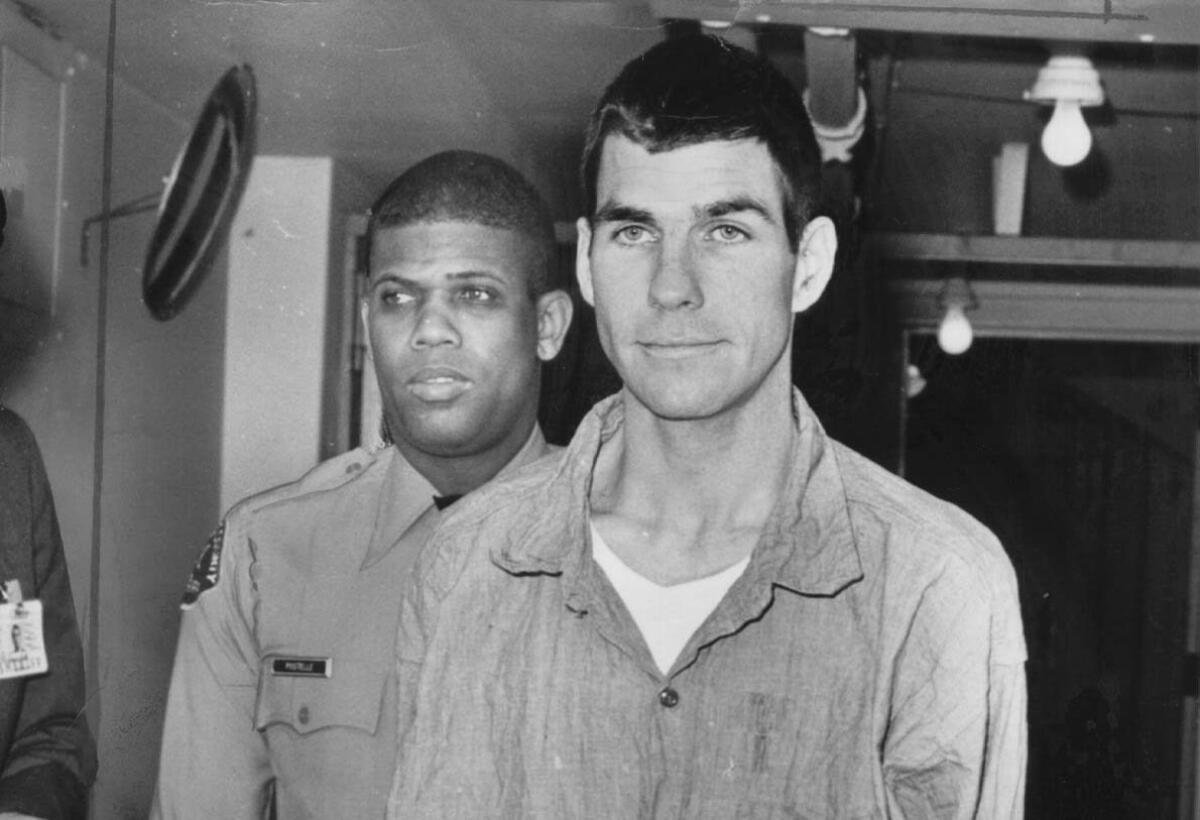How many more did Manson family kill? LAPD investigating 12 unsolved murders

The Manson murders mostly are remembered as two events that occurred 50 years ago this month: the killing of actress Sharon Tate and four others in Benedict Canyon and then the butchering of Leno and Rosemary LaBianca in Los Feliz.
But cold-case investigators and others long have believed that Charles Manson and his cult followers were responsible for many more deaths.
The Los Angeles Police Department officially has a dozen unsolved homicide cases linked to Manson. And there are additional slayings outside the jurisdiction that some believe to be the work of his “family.” Some of those ties seem more plausible than others, but all have been extensively examined and theorized — as are all things involving Manson.

The supposed suicide of one Manson follower’s boyfriend in England. The drowning of an attorney whom Manson declared during the middle of his trial he never wanted to see again. A young man killed during a game of Russian roulette with family members present. Two young women stabbed to death off Mulholland Drive and a couple of young Scientology followers who met a similar fate.
Manson “repeatedly” said many others were killed, said Cliff Shepard, a former LAPD Robbery-Homicide Division detective who worked some of those cold cases. “We may never know or identify all their victims.”
In all, Manson and his followers were convicted of nine murders — the Tate and LaBianca attacks plus the slayings of musician Gary Hinman and stuntman and ranch hand Donald “Shorty” Shea.
Dan Jenks, an LAPD Robbery-Homicide detective, said the unsolved cases still were under active investigation and that the department would not comment on specifics.
“There is no statute of limitations. We are always developing new techniques. The last 10 years, DNA has come a long way,” Jenks said. “We will stay on them and keep them as active as we can.”
The LAPD repeatedly has declined requests by the Los Angeles Times for information about those cases. But seven years ago, while seeking to obtain audiotapes of a Manson follower that detectives hoped would yield clues, the department formally declared that a dozen unsolved cases might be tied to the family.
The tapes involved conversations between convicted killer Charles “Tex” Watson and his attorney in 1969. The LAPD obtained the tapes after a legal battle, but they appeared to provide few clues. The department, however, refused a Times request to review them, citing ongoing investigations. A judge in 2017 ruled that attorneys for Manson follower Leslie Van Houten could not have the recordings as part of her efforts to gain parole.
“The thing we discovered after reviewing the tapes, there was no new information related to any of the unsolved cases,” Jenks said. The death of Manson in 2017, as well as those of other family members, has made efforts to pursue the cases harder.
Manson prosecutor Stephen Kay said he and his partner, the late Vincent T. Bugliosi, always suspected that the cult had killed others.
“I know that Manson one time told one of his cellmates that he was responsible for 35 murders,” said Kay, who has attended 60 or so parole hearings to keep those he convicted of the Manson slayings in prison. “Whether that is true or not or just jail bragging, I don’t know. We prosecuted him for nine murders, and those were all the murders we had evidence on.”
A suspicious death in London
Just months after the Tate and LaBianca murders, Joel Pugh — the 29-year-old boyfriend of Manson clan member Sandra Good — was found dead in the Talgarth Hotel in London. His wrists and throat had been cut. British authorities listed it as a suicide, saying Pugh had been depressed. No suicide note was left.
Kay and others said Manson hated Pugh. “He had no reason to commit suicide, and Manson was very unhappy that Sandy” was with Pugh, Kay said.
Manson follower Bruce M. Davis, who recently was cleared for parole after nearly 50 years in prison, was in London at the time Pugh died. Kay said that Davis, now 76, was the family member most able to kill. The prospect of his pending release — which still could be blocked by Gov. Gavin Newsom — has energized investigations during the last decade.
Davis was convicted in the killings of Hinman and Shea in 1971 and sentenced to death. When California for a time abolished the death penalty, Davis and other members of the family were given life sentences.
At a parole hearing, Davis said he hadn’t known about the Tate killings until the morning after they happened but had committed the other murders because “I wanted to be Charlie’s favorite guy.”
Deadly game of Russian Roulette
Davis also was a witness to the November 1969 death of John “Zero” Haught in Venice, according to investigators. Authorities concluded that Haught had died accidentally while playing Russian roulette with a revolver, but that finding came under question.
The gun recovered didn’t have any fingerprints on it, The Times’ Jerry Cohen reported in 1969. A young man who held Haight’s head after the shooting told Cohen he entered the room to find a female Manson follower with the gun in her hand. Several Manson followers were inside the home that night, including Davis, The Times reported.
Davis could not be reached for comment, and his attorney did not return messages.
Jane Doe 59
In his book about the Manson family murders, “Helter Skelter,” Bugliosi said he believed that a woman known for years only as Jane Doe 59 was killed because she had witnessed Haught’s killing.
She was stabbed 150 times. A bird-watcher discovered her remains on Mulholland Drive, about six miles from the Benedict Canyon home where Tate and the others were killed.
Three years ago, the LAPD identified her as 19-year-old Reet Jurvetson from Montreal, using a DNA sample from her sister. She had come to Los Angeles from Canada to join a man she had first met in a Montreal coffee shop.
“She thought he looked like Jim Morrison,” Shepard, the former LAPD detective, said.
She sent a postcard to her mother about getting an apartment in L.A. 16 days before her death.
LAPD detectives asked Manson about Jurvetson before the killer’s death. He denied knowing her.
“It was like talking to a wall,” said LAPD Robbery-Homicide Division Capt. Billy Hayes.
That Manson wouldn’t say much doesn’t surprise his son.
Manson’s son Michael Brunner told The Times recently that “Charlie lived by a code. He was an outlaw. He was not a nice guy. But he lived by a code and he was not gonna be the one that was snitching. And there was a lot of snitching going on. And the people that were snitching, you know, they say snitches get stitches.”
Shepard said much of the speculation about Jurvetson stemmed from a photo of a woman resembling her who was dancing at the family’s Spahn Ranch hangout with Manson follower Steve Dennis “Clem” Grogan. He was paroled in 1985 after being convicted of murder for his role in Shea’s death.
Grogan told detectives a few years ago that the woman was another Manson follower, not the Jane Doe, Shepard said.
Still, the LAPD has not ruled out the Manson cult in her killing.
A violent time
Complicating the effort to solve Jurvetson’s murder is the fact that the period of the late 1960s and ’70s was marked by numerous serial killers roaming California.
Sandi Gibbons, a former City News Service reporter who later served as the spokeswoman for several L.A. County district attorneys, said the area off Mulholland was a popular place for dumping bodies at the time.
On New Year’s Day 1969, the body of 17-year-old Marina Habe — who was kidnapped outside her West Hollywood home — was found less than half a mile from Jurvetson’s remains in a ravine off Mulholland Drive. Habe, the daughter of a Hollywood screenwriter, also had multiple stab wounds to her neck.
Shepard said Manson also was asked about Habe and dismissed any suggestion she was one of his crowd.
LAPD homicide detectives also saw similarities between the vicious knife attack on Jurvetson and the November 1969 killings of James Sharp, 15, of Crestwood, Mo., and Doreen Gaul, 19, from Albany, N.Y. Stabbed and beaten, their bodies were dumped in a downtown Los Angeles alley a week before the discovery of Jurvetson’s remains.
At the time, LAPD Lt. Earl Deemer described the wounds on the pair as being inflicted by a “fanatic.” Each had been stabbed 50 to 60 times. In “Helter Skelter,” Bugliosi wrote that Gaul was rumored to be a former girlfriend of Davis — who, like the dead teenagers, once was a Scientologist.
Davis had lived at the same housing complex as Gaul, but in a police interview in the 1970s he denied knowing her. Years later, another man confessed to killing the pair in a robbery but was never charged. He has since died.
Death of a lawyer
Then there was the death of Ronald Hughes.
The 35-year-old attorney strongly defended Leslie Van Houten during the family’s murder trial, seemingly at the expense of Manson.
“We recessed for the weekend, and Manson — who sat in the corner of the counsel table — pointed to Hughes and said to her attorney: ‘I don’t want to see you in this courtroom again.’ And we never saw him again,” Kay said.
In late November 1970, as the trial neared its end, Hughes disappeared. Four months later, his decomposed body turned up wedged in a rocky creek in Ventura County. Kay said Hughes was last seen swimming in the nearby hot springs right before a flash flood.
In “Helter Skelter” and in later interviews, Bugliosi suggested that Manson directed Hughes’ killing, calling it “the first of the retaliation murders.”
But Charlie Rudd, a retired Ventura County sheriff’s sergeant, told The Times in 2012 that Hughes’ death probably had nothing to do with Manson. Authorities recovered Hughes’ body near Sespe Hot Springs in the Los Padres National Forest, and Rudd said there was little evidence of foul play.
According to Rudd, the creek probably swelled dangerously and Hughes died either because he drowned or because he was battered to death by debris and rocks. “There was nothing else to indicate otherwise, and the medical examiner couldn’t come to a conclusion of anything other than that.”
Was Hughes murdered? Kay said he wasn’t so sure.
“I’m on the fence.”
Times staff writers Maria L. La Ganga and Hector Becerra contributed to this report.
More to Read
Sign up for Essential California
The most important California stories and recommendations in your inbox every morning.
You may occasionally receive promotional content from the Los Angeles Times.











